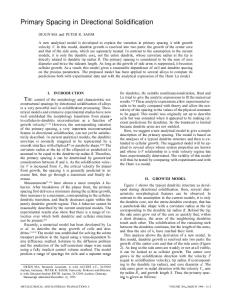Effect of Shrinkage on Primary Dendrite Arm Spacing during Binary Al-Si Alloy Solidification
- PDF / 1,039,255 Bytes
- 15 Pages / 593.972 x 792 pts Page_size
- 42 Downloads / 311 Views
mechanisms that could induce fluid flow during solidification. Various algorithms were proposed to simulate the solidification of binary alloys.[5–8] Numerical models used in these algorithms focused primarily on the development of fluid flow during solidification in the entire computational domain. The density of solid was assumed equal to that of the liquid phase. Therefore, the effect of shrinkage was absent. Some of these algorithms were further developed[9–12] with consideration of density variation between liquid and solid phases. However, these studies[9–12] combined the fluid flow caused by shrinkage and natural convection and HONGDA WANG, Postdoctoral Candidate, is with Light Metal Casting Research Centre (LMCRC), McMaster University, Hamilton, ON L8S 4L7, Canada, and is also with Thermal Processing Laboratory (TPL), McMaster University. MOHAMED S. HAMED, Associate Professor, is with Thermal Processing Laboratory (TPL), McMaster University. Contact e-mail: [email protected] SUMANTH SHANKAR, Associate Professor, is with Light Metal Casting Research Centre (LMCRC), McMaster University. Manuscript submitted July 8, 2010. Article published online February 23, 2011 METALLURGICAL AND MATERIALS TRANSACTIONS A
failed to differentiate between them. A few investigations[13,14] only focused on the effect of shrinkage alone on the fluid flow; however, there was no correlation between the fluid flow caused by shrinkage and the primary dendrite arm spacing. To enable a correlation between fluid flow and the primary dendrite arm spacing, this study developed a model to simulate solidification in a macroscale control volume (CV) (~1 mm) with optimized thermophysical material properties, accounting for the effect of undercooling of liquidus temperature prior to the solidification event, DT, employing appropriate models to predict k1, and considering the effect of fluid flow in the liquid caused by both shrinkage and natural convection. Xu and Li[13] were among the earliest researchers who considered different density values for the solid and liquid phases (shrinkage) and evaluated fluid flow patterns in the computing domain during solidification. They found that there is a significant increase in the pressure drop inside the mushy zone (region where solid and liquid phases coexisted) when compared to that in the liquid phase. Hence, it was conjectured that inside the mushy zone, fluid flow induced by shrinkage was dominant over that induced by natural convection. VOLUME 42A, AUGUST 2011—2331
Chiang and Tsai[14] investigated the effect of shrinkage on the solidification of 1 pct Cr- steel alloy in a rectangular cavity with a riser on the top away from the heat extraction boundary. All sides of the cavity were insulated, except the chilled bottom. Numerical results with shrinkage were compared with the pure diffusion case (without any fluid flow). It was reported that considering solidification shrinkage resulted in higher temperatures close to the heat extraction boundary and lower temperatures close to the top of the riser. Chiang and Tsai[15] also investig
Data Loading...










